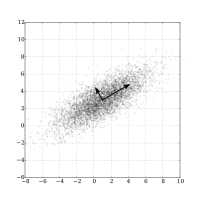
Photo from wikipedia
Gait analysis has traditionally relied on laborious and lab-based methods. Data from wearable sensors, such as Inertial Measurement Units (IMU), can be analyzed with machine learning to perform gait analysis… Click to show full abstract
Gait analysis has traditionally relied on laborious and lab-based methods. Data from wearable sensors, such as Inertial Measurement Units (IMU), can be analyzed with machine learning to perform gait analysis in real-world environments. This database provides data from thirty participants (fifteen males and fifteen females, 23.5 ± 4.2 years, 169.3 ± 21.5 cm, 70.9 ± 13.9 kg) who wore six IMUs while walking on nine outdoor surfaces with self-selected speed (16.4 ± 4.2 seconds per trial). This is the first publicly available database focused on capturing gait patterns of typical real-world environments, such as grade (up-, down-, and cross-slopes), regularity (paved, uneven stone, grass), and stair negotiation (up and down). As such, the database contains data with only subtle differences between conditions, allowing for the development of robust analysis techniques capable of detecting small, but significant changes in gait mechanics. With analysis code provided, we anticipate that this database will provide a foundation for research that explores machine learning applications for mobile sensing and real-time recognition of subtle gait adaptations. Measurement(s) Gait Technology Type(s) Sensor Device Factor Type(s) surface • age • sex • height • body mass Sample Characteristic - Organism Homo sapiens Machine-accessible metadata file describing the reported data: https://doi.org/10.6084/m9.figshare.12505022
Journal Title: Scientific Data
Year Published: 2020
Link to full text (if available)
Share on Social Media: Sign Up to like & get
recommendations!